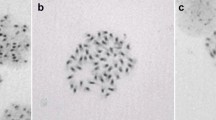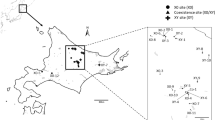Abstract
Combinations of DNA-binding fluorescent dyes and counterstains that enhance selectivity and contrast in primary stain fluorescence were used to differentiate types of C-bands in the genus Warramaba. Chromomycin A3 (in conjunction with two A-T binding counterstains), which identifies chromosome segments enriched in G-C base pair clusters, stains only a minority of the C-bands in Warramaba species, but these include all those known to contain 18S + 26S rRNA cistrons and most of those containing 5S rRNA genes. DAPI/actinomycin D fluorescent staining is positive for a very few bands, including two (in the Standard phylad of W. virgo) that are at or adjacent to sites containing 5S rRNA cistrons. One of the latter regions is also positively stained by DAPI/distamycin A which, in addition, highlights some centromeric bands. The fluorescent staining patterns of the Standard and Boulder-Zanthus phylads of W. virgo are significantly different, confirming their independent origin by hybridization between different races of the ancestral species “P169” and “P196”.
Similar content being viewed by others
References
Appels R (1982) The molecular cytology of wheat-rye hybrids. Int Rev Cytol 80:93–132
Bennett MD (1982) Nucleotypic basis of the spatial ordering of chromosomes in eukaryotes and the implications of the order for genome evolution and phenotypic variation. In: Dover GA, Flavell RB (eds) Genome evolution. Academic Press, New York, p 239–261
Brown DD, Weber CS (1968) Gene linkage by RNA-DNA hybridization. Unique DNA sequences homologous to 4s RNA, 5s DNA and ribosomal RNA. J Mol Biol 34:661–680
Dennis ES, Peacock WJ, White MJD, Appels R, Contreras N (1981) Cytogenetics of the parthenogenetic grasshopper Warramaba virgo and its bisexual relatives. VII. Evidence from repeated DNA sequences for a dual origin of W. virgo. Chromosoma 82:453–469
Deumling B, Greilhuber J (1982) Characterization of heterochromatin in different species of the Scilla siberica group (Liliaceae) by in situ hybridization of satellite DNAs and fluorochrome banding. Chromosoma 84:535–555
Dover G (1982) Molecular drive: a cohesive mode of species evolution. Nature 299:111–117
Sahar E, Latt SA (1980) Energy transfer and binding competition between dyes used to enhance staining differentiation in metaphase chromosomes. Chromosoma 79:1–28
Schmid M (1982) Chromosome banding in Amphibia. VII. Analysis of the structure and variability of NORs in Anura. Chromosoma 87:327–344
Schwarzacher T, Schweizer D (1982) Karyotype analysis and heterochromatin differentiation with Giemsa C-banding and fluorescent counterstaining in Cephalanthera (Orchidaceae). Pl Syst Evol 141:91–113
Schweizer D (1976) Reverse fluorescent chromosome banding with chromomycin and DAPI. Chromosoma 58:307–324
Schweizer D (1980a) Fluorescent chromosome banding in plants: applications, mechanisms, and implications for chromosome structure. In: Davies DR, Hopwood RA (eds) Proc. 4th John Innes Symposium, Norwich 1979; The plant genome. John Innes Charity, Norwich, p 61–72
Schweizer D (1980b) Simultaneous fluorescent staining of R bands and specific heterochromatic regions (DA-DAPI bands) in human chromosomes. Cytogenet Cell Genet 27:190–193
Schweizer D (1981) Counterstain-enhanced chromosome banding. Hum Genet 57:1–14
Schweizer D (1983) Distamycin-DAPI bands: properties and occurrence in species. In: Bennett MD, Brandham P (eds) Kew Chromosome Conference II. London, Allen and Unwin, 43–51
Scott NS, Ingle J (1973) The genes for cytoplasmic ribosomal ribonucleic acid in higher plants. Plant Physiol 51:677–684
Webb GC, White MJD, Contreras N, Cheney J (1978) Cytogenetics of the parthenogenetic grasshopper Warramaba (formerly Moraba) virgo and its bisexual relatives. IV. Chromosome banding studies. Chromosoma 67:309–339
White MJD (1980) The genetic system of the parthenogenetic grasshopper Warramaba virgo. In: Blackman RL, Hewitt GM, Ashburner M (eds) Insect cytogenetics. Symp X. Roy Entomol Soc London. Oxford, Blackwell Sci Publ, p 119–131
White MJD, Contreras N (1981) Chromosome architecture of the parthenogenetic grasshopper Warramaba virgo and its bisexual ancestors. Chromosomes Today 7:165–175
White MJD, Contreras N (1982) Cytogenetics of the parthenogenetic grasshopper Warramaba virgo and its bisexual relatives. VIII. Karyotypes and C-banding patterns in the clones of W. virgo. Cytogenet Cell Genet 34:168–177
White MJD, Webb GC, Contreras N (1980) Cytogenetics of the parthenogenetic grasshopper Warramaba (formerly Moraba) virgo and its bisexual relatives. VI. DNA replication patterns of the chromosomes. Chromosoma 81:213–248
White MJD, Dennis ES, Honeycutt RL, Contreras N, Peacock WJ (1982) Cytogenetics of the parthenogenetic grasshopper Warramaba virgo and its bisexual relatives. IX. The ribosomal RNA cistrons. Chromosoma 85:181–199
Author information
Authors and Affiliations
Rights and permissions
About this article
Cite this article
Schweizer, D., Mendelak, M., White, M.J.D. et al. Cytogenetics of the parthenogenetic grasshopper Warramaba virgo and its bisexual relatives. Chromosoma 88, 227–236 (1983). https://doi.org/10.1007/BF00285625
Received:
Issue Date:
DOI: https://doi.org/10.1007/BF00285625




